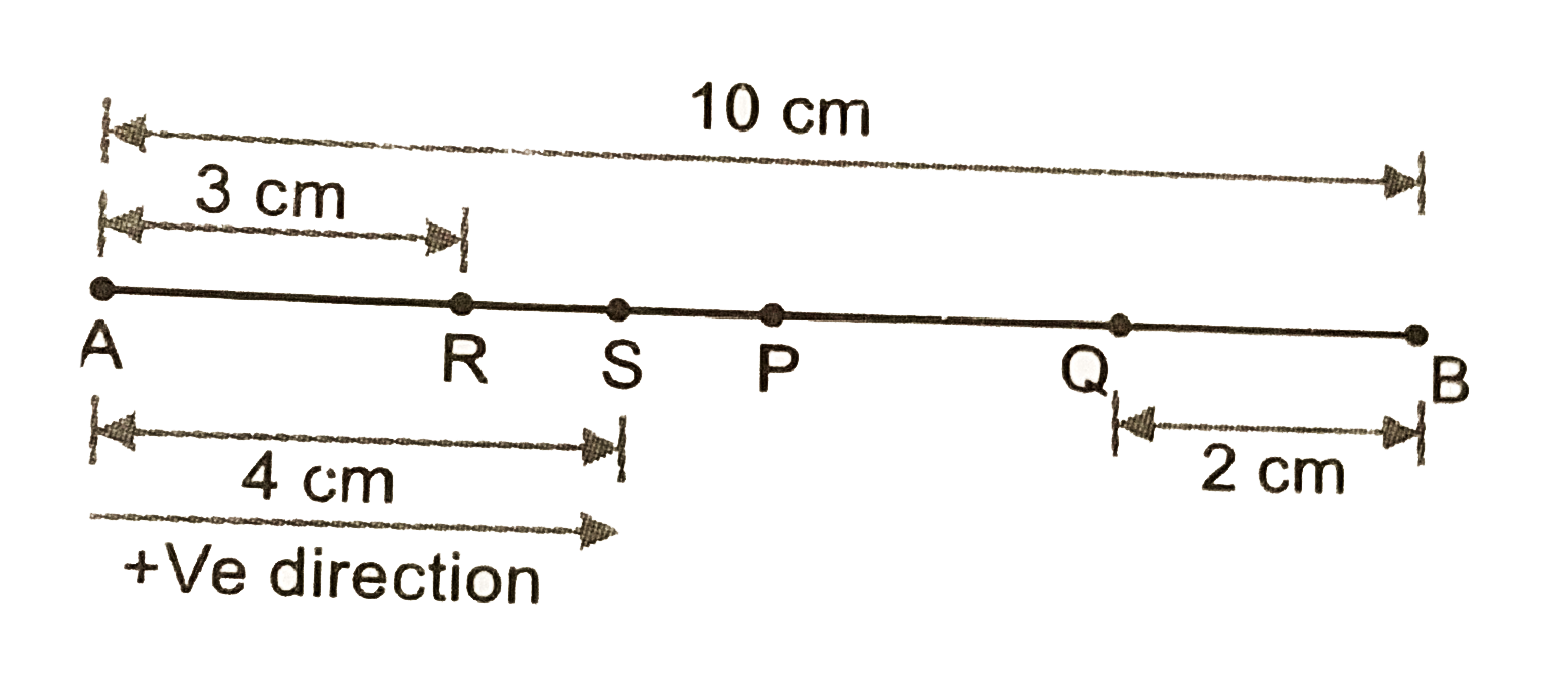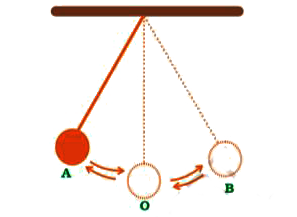A particle is in linear simple harmonic motion between two points A and B, 10 cm apart (figure) . Take the direction from A to B as the +ve direction and choose the correct statements.

The sign of velocity, acceleration and force on the particle when it is 3 cm away from A going towards B are positive.
The sign of velocity of the particle at C going towards O is negative.
the sign of velocity, acceleration and force on the particle when it is 4 cm away from B A going towards A are negative.
The sign of acceleration and force on the particle when it is at point B is negative.
The correct Answer is:A, C, D
The direction from A to B (or from A towards mean position O) is positive. So, when the particle is going from A towards B and is at C(3 cm away from A), its velocity, acceleration and force are positive. When the particle goes from B to A< when its is 4 cm away from point B( going towards mean position 0), its velocity and acceleration are negative. Hence, force is also positive. Point B is an extreme position, so when the particle is at this position, the direction of the force as well as the acceleration is towards point O, hence negative.
Topper's Solved these Questions
- OSCILLATIONS BOOK - MODERN PUBLICATIONCHAPTER - OSCILLATIONS EXERCISE - NCERT Exemplar Problems Subjective Question (Very short Answer Type Questions )
10 Videos
- OSCILLATIONS BOOK - MODERN PUBLICATIONCHAPTER - OSCILLATIONS EXERCISE - NCERT Exemplar Problems Subjective Question ( short Answer Type Questions )
6 Videos
- OSCILLATIONS BOOK - MODERN PUBLICATIONCHAPTER - OSCILLATIONS EXERCISE - NCERT Exemplar Problems Subjective Question (Multiple Choice Questions (Type-I))
11 Videos
- MOTION IN A STRAIGHT LINE BOOK - MODERN PUBLICATIONCHAPTER - MOTION IN A STRAIGHT LINE EXERCISE - CHAPTER PRACTICE TEST
16 Videos
- PHYSICAL WORLD BOOK - MODERN PUBLICATIONCHAPTER - PHYSICAL WORLD EXERCISE - Revision exercises (Long answer questions)
6 Videos
Similar Questions
A particle is in linear S.H.M. between two points A and B, 10 cm apart. Take the direction from A to B as the positive direction and give the signs of velocity, acceleration and force on the particle when it is.
(a) at the end (A) at the end B,
(c) at the mid point of AB going towards A,
(d) at 2 cm away from B going towards A,
(e) at 3 cm away from A goiing towards B, and
(f) at 4 cm away from A going towards A.

View SolutionThe energy of a particle executing simple harmonic motion is given by E=Ax2+Bv2 where x is the displacement from mean position x=0 and v is the velocity of the particle at x then choose the correct statement(s)
View Solution
Knowledge Check
A particle is in linear simple harmonic motion between two points A and B10cm apart (figure). Take the direction form A to B as positive direction and choose the correct statements.
AO=OB=5cm
BC=8cm
 AThe sign of velocity, acceleration and force on the particle when it is 3cm away from A going towards B are positiveBThe sign of velocity of the particle at C going towards B is negativeCThe sign of velocity, acceleration and force on the particle when it is 4cm away from B going towards A are negativeDThe sign of acceleration and force on the particle when it is at point B is negative
AThe sign of velocity, acceleration and force on the particle when it is 3cm away from A going towards B are positiveBThe sign of velocity of the particle at C going towards B is negativeCThe sign of velocity, acceleration and force on the particle when it is 4cm away from B going towards A are negativeDThe sign of acceleration and force on the particle when it is at point B is negativeA particle is in linear simple harmonic motion between two points. A and B, 10 cm apart (figure.) take direction from A to B as the positive direction and choose the correct statements.

AO= OB= 5cm
BC=8cmAThe sing of velocity, acceleration and force on the particle when it is 3 cm away from A going towards B are positiveBThe sign of velocity of the particle at C going towards B is negativeCThe sign of volocity, acceleration and force on the particle when it is 4 cm away form B going towards A are negativeDThe sign of acceleration and force on the particle when it is at points B is negativeA particle is executing simple harmonic motion between exterme positions given by (−1,−2,−3)cm and (1,2,1)cm. Its amplitude of oscillation is
A6cmB24cmC2cmD3cm
A simple pendulum is oscillating between two points A and B as shown in Figure 13.5. Is the motion of the bob uniform or non-uniform?

View SolutionA particle is executing simple harmonic motion with maximum velocity of 20 cm/s. Calculate the average velocity during its motion from one extreme to another.
View SolutionA particle executes linear simple harmonic motion with an amplitude of 3cm. When the particle is at 2cm from the mean position, the magnitude of its velocity is equal to that of its acceleration. Then, its time period in seconds is
View SolutionA particle executes linear simple harmonic motion with an amplitude of 2 cm . When the particle is at 1 cm from the mean position the magnitude of its velocity is equal to that of its acceleration. Then its time period in seconds is
View SolutionTwo particles execute simple harmonic motion of the same amplitude and frequency along close parallel lines. They pass each other moving in opposite directions each time their displacement is half their amplitude. Their phase difference is
View Solution
